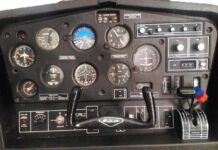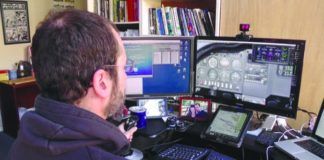Parkersburg Express from the January 2012 edition reminded how a similar T-type RNAV approach to Tupelo, Miss., gave me troubles when I was cleared to the IF/IAF (ARMRR) as I requested.
The Tupelo approach is in a non-radar environment; I was coming from the southeast, and I was cleared direct ARMRR, maintain 4000 until ARMRR, which is 1900 feet above the published crossing altitude for ARMRR.
That 1900 feet is pretty hard to lose in six miles in a 35 Bonanza with time to level off, stabilize, engage the autopilot in ALT hold mode so that it will capture the LPV glideslope, and slow down enough for my 124-knot gear speed. I could have slowed down and gotten the gear out before reaching ARMRR, but that goes against my SOP of dropping the gear at the FAF.
The article/quiz indicates that cleared for the RNAV approach without an altitude restriction and within the TAA we are considered established and can descend to the sector’s minimum altitude on the approach plate. Had I been cleared to ARMRR for the approach and without an altitude restriction, I could have descended to 3400 within 30 miles of ARMRR and 2100 within 16 miles of ARMRR without further permission from ATC.
Am I ever likely to get that in a non-radar environment? Are my local controllers not understanding that once I am going direct to an RNAV IAF and within the TAA sector’s safe altitude range, that I am “established” on the approach? If so, education would be the fix.
Memphis Center also tends to keep us at 3000 for the ILS when vectoring onto the final approach course, often putting us so close (two to three miles) to the VERON LOM that we can’t get down to the 2000-foot crossing altitude.
I know there are rules about how close they can vector you onto the localizer, they just don’t seem to follow that rule. In fact, I did the RNAV 36 in order to try to avoid the problems I’ve had with being vectored too close on the ILS!
Justin Graff
Belden, Miss.
Many controllers aren’t well versed with the TAA RNAV approaches, and will simply use MVAs until you hit the IAF/IF. You can do the education with a request of “We’re established at 25 miles southeast of ARMRR and would like to descend to 3400 as published.” There should be no issue that it’s non-radar other than you may be asked to report ARMRR.
There’s no such help getting vectored to an ILS. You’ll be at their MVA until established. Asking for an intercept further out is probably the best solution. You could also ask for direct to the LOM for the full procedure and do the descent and PT yourself if that’s an option.
Great Service from the FAA …
Regarding the letter from Steve Schunk and the article “ATC Improv on Decline” (both in January 2012 IFR): I am based at Somerset Airport in Bedminster, N.J., and my experiences with New York controllers have been uniformly positive.
I frequently fly east to destinations such as Block Island and I have never had a problem getting clearance through the Class Bravo or getting VFR advisories when flying in other directions.
Regarding getting handoffs from other sectors, my experience has been the same. On a recent flight coming home from Cape May County Airport (nice restaurant and great aviation museum), I received a timely handoff from McGuire Approach.
I was even able to get an IFR descent from my present altitude (about 6500) down to 3000 when sky conditions changed from scattered to overcast over north Jersey. After I gave my request, I was told to consider myself IFR and to tell him when I was ready to cancel IFR. I think they’re the best.
Robert Checchio
Dunellen, N.J.
… But No Help From FSS
Your January 2012 editorial, “Getting What We Pay For,” hit close to home. Last winter, I studied the TAFs and FAs for a flight the next morning from New York to Kansas City. The questionable area was a region of possible icing through the center of Pennsylvania and Ohio, and I was particularly concerned about making the right “go/no go” decision since a TBM 700 went down the previous day, possibly due to icing.
I decided to call FSS that evening before my flight, which I rarely do because I can usually find all the information I need online and in most cases the only thing the briefer does is regurgitate what they see on ADDS. I wanted a professional opinion that could understand the conditions that might prevail the next day. I ended up with probably the worst briefing I’ve ever received.
I asked for a briefer from my area of departure. It was obvious from the start that she had little insight into tomorrow’s forecast beyond a rote recitation of the prog charts. She ended the briefing with a chuckle and said, “Well you never know, the weather can always change.”
If FSS is to continue to provide vital weather information to pilots, then they need to train their briefers to provide better and more insightful information. To be fair, I have on occasion gotten a briefer that understood what he was reading and was extremely helpful, but those times are getting more and more rare.
Ron Davis,
Lenexa, Kan.
Microsoft FS? Not Yet
Many months back in Briefing you mentioned that Microsoft was going to start redevelopment of their Flight Simulator software program. Any update on that statement?
Bruce Thompson
Denver, Colo.
The plan is apparently an online game that you can subscribe to for additional functionality. We won’t know more until they release it. The hype can be found at www.microsoft.com/games/flight/.
Informal Risk Eval Works
Great article on “Launching with Failures” (August 2011 IFR), which highlights the dichotomy between actual risk evaluation and regulatory enforcement. The article does a nice job of approaching the risk in a qualitative manner. A more formal approach would be using classical risk methods: Risk = Likelihood * Consequences * Exposure.
Given the single-exposure the flight conditions and pilot experience, the real (not regulatory) risk would be well within expected values for an experienced GA pilot.
Paul Lahoud
Huntsville, Ala.
Cheaper Than Reported
I enjoy reading your magazine and appreciate the coverage of our IFR Mastery online training (“IFR Proficiency Online,” February 2010 IFR). Just so your readers know, we waive the $199 fee for online membership, so it’s just $19 a month if anyone wants to try it out at www.pilotworkshop.com.
Mark Robidoux
Nashua, N.H.
Make your readback to [email protected].




